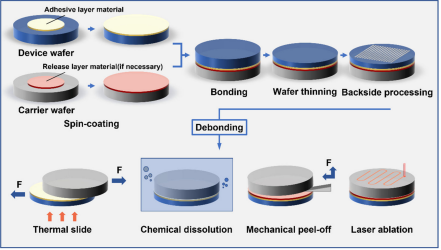Temporary bonding/debonding (TBDB) technologies have greatly contributed to thereliable fabrication of thin devices. However, the rapid development of large-scale, high-precisionand ultra-thin devices in the semiconductor field has also proposed more stringent requirements forTBDB technologies. Here, we deliberate the recent progress of materials for temporary bonding anddifferent debonding technologies over the past decade. Several common debonding methods aredescribed, including thermal slide, wet chemical dissolution, mechanical peeling and laser ablation.We review the current status of different debonding technologies and highlight the applicationsof TBDB technologies in advanced electronic packaging. Possible solutions are proposed for thechallenges and opportunities faced by different TBDB technologies. Ultimately, we attempt to proposean outlook on their future development and more possible applications. We believe that the simpleschematics and refined data presented in this review would give readers a deep understanding ofTBDB technologies and their vast application scenarios in future advanced electronic packaging.
In recent years, with the rapid development of 5G, artificial intelligence, Internetof Things, automatic driving and big data, electronic devices are developing towardsminiaturization and multi-function. In order to achieve high performance of electronics, advanced package technologies such as fan-out wafer level package (FOWLP) [1,2],2.5D interposer and 3D package (e.g., through-silicon via, package on package, microelectro-mechanical system) have been developed [3–10]. In 3D chip stacking, a range ofpolymer-based adhesives typically bonds the device wafer to the carrier wafer, which isinsensitive to the flatness and cleanliness of the device wafer surface. Because of their simplicity, robustness and low cost, adhesives are widely used throughout the microelectronicsand micro-electro-mechanical system (MEMS) manufacturing process. These adhesivesinclude polymers such as epoxy resins, dry films, benzocyclobutene (BCB), polyimideand UV-curable compounds [11–15]. They have the advantage of being relatively lowtemperature and can protect sensitive components. In addition, they can be divided intopermanent adhesive bonding and temporary adhesive bonding, depending on whether thewafers are separated again after bonding [16]. The comparison between parament bondingand temporary bonding is listed in Table 1. In contrast to temporary bonding, the adhesivesused for permanent bonding generally need to meet low dielectric constants, low waterabsorption, high bond strength and high stability. Permanent bonding technology helps toreduce the footprint and significantly improve product performance. Permanent bondingtechnology is mainly used in semiconductor applications such as radio frequency (RF),MEMS, light emitting diodes (LED), time of flight (ToF) devices and especially in emergingsensors such as complementary metal oxide semiconductors (CMOS).
In contrast to the permanent bonding process, the temporary bonding process wasoriginally developed to hold and protect ultrathin wafers. Since thicker wafers are difficultto meet the heat dissipation and packaging requirements of high-end chips, wafer thinningto the required thickness is often required in the semiconductor field. However, whenthe thickness of the wafer is reduced to less than 200 µm, the ultra-thin wafers becomebrittle and prone to warp [20]. Therefore, the semiconductor industry has proposedvarious temporary bonding/debonding (TBDB) technologies, in which device wafers aretemporarily bonded to thicker rigid carriers with appropriate adhesives [21]. Figure 1shows an overview of the different TBDB technologies for advanced packaging. After thesedevice wafers are thinned, and the back-end fabrication process is completed, the carriersand adhesives need to be removed non-destructively. Therefore, it is crucial to developvarious adhesives and corresponding debonding processes that can meet the requirementsof TBDB technology. A suitable temporary material should provide sufficient adhesion tothe wafer during the thinning process. Moreover, it should be resistant to acids and alkalisand high temperatures in order to remain stable during the backside processes such ascuring, grinding, etching, metallization, etc., prior to debonding.
Over the past 20 years, temporary bonding materials have been continuously updatedand iterated. Initially, liquid wax was developed by Nikka Seiko for temporary bonding.Inorganic materials (a-Si:H, etc.) and polymers (polyimide, polyether ether ketone (PEEK),polydimethylsiloxane (PDMS), etc.) were also later adopted as temporary bonding materials [22–26]. Moreover, the main difference between these temporary bonding materials isthat a corresponding debonding method needs to be developed to meet the non-destructivedebonding of ultrathin wafers. Furthermore, the development of advanced temporarybonding materials and debonding processes has been a relentless goal of researchers. Thefirst generation of temporary bonding materials was used for the thermal slide debonding process, such as Space Liquid from Nikka Seiko, HT series materials from BrewerScience [27–31], JSR [32], etc.; as the application scenarios changed, materials and techniques for debonding using solvents (e.g., Zero Newton temporary debonding system fromTOK [33,34]), mechanical forces (e.g., BrewerBOND®305) [35] or lasers (e.g., 3M WSS [36],HD-3007 from HDMS [23], BrewerBOND®701 [37–39]) to release were developed. Specialtechnologies such as ZoneBOND® [40] and air-jetting were developed [41,42]. In addition,hydrogenated amorphous silicon (a:Si-H) [22,43] and various polymers, such as polyelec-trolyte [44], iCVD polyglycidylmethacrylate (PGMA) [45] and polydimethylglutarimide(PMGI) [46], have also been used as temporary bonding materials.

Fig1
Although debonding with solvents does not leave any residue on the wafer, it consumes a large amount of solvent. Moreover, possible warpage and the use of porous wafersincrease the costs. Obviously, these drawbacks greatly hinder the widespread applicationof chemical dissolution debonding in advanced electronics packaging.
上一篇: 结晶材料表面和结晶度分析的新型组合方法